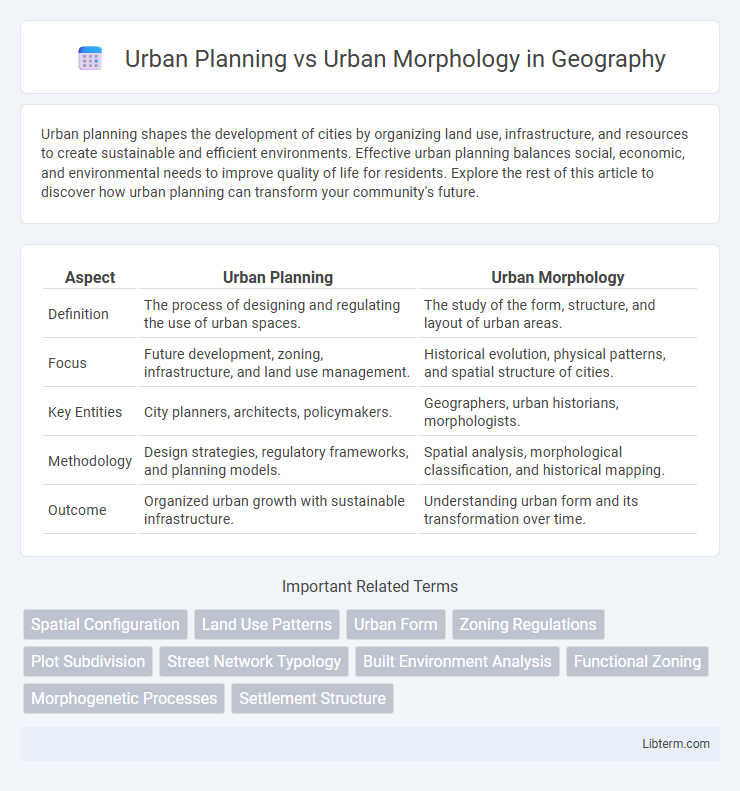Urban planning shapes the development of cities by organizing land use, infrastructure, and resources to create sustainable and efficient environments. Effective urban planning balances social, economic, and environmental needs to improve quality of life for residents. Explore the rest of this article to discover how urban planning can transform your community's future.
Table of Comparison
| Aspect | Urban Planning | Urban Morphology |
|---|---|---|
| Definition | The process of designing and regulating the use of urban spaces. | The study of the form, structure, and layout of urban areas. |
| Focus | Future development, zoning, infrastructure, and land use management. | Historical evolution, physical patterns, and spatial structure of cities. |
| Key Entities | City planners, architects, policymakers. | Geographers, urban historians, morphologists. |
| Methodology | Design strategies, regulatory frameworks, and planning models. | Spatial analysis, morphological classification, and historical mapping. |
| Outcome | Organized urban growth with sustainable infrastructure. | Understanding urban form and its transformation over time. |
Introduction to Urban Planning and Urban Morphology
Urban planning involves the strategic design and regulation of land use, infrastructure, and public spaces to create functional, sustainable cities that meet the needs of their inhabitants. Urban morphology studies the form and structure of urban spaces, analyzing patterns of streets, buildings, and open areas to understand historical development and spatial organization. Both fields intersect by connecting physical urban forms with planning processes to optimize urban environments for social, economic, and environmental outcomes.
Defining Urban Planning: Scope and Objectives
Urban Planning encompasses the strategic design and regulation of land use, infrastructure, and community services aimed at fostering sustainable, functional, and aesthetically pleasing urban environments. Its scope includes zoning, transportation networks, public spaces, housing development, and environmental management to address social, economic, and ecological objectives. The primary goal of Urban Planning is to optimize urban growth and quality of life through coordinated policies that balance development needs with resource conservation and social equity.
Understanding Urban Morphology: Key Concepts
Urban morphology examines the form and structure of urban spaces, analyzing elements like street patterns, building types, and plot layouts to understand city development over time. Key concepts include the study of urban fabric, which encompasses the arrangement and relationship of physical components, and the differentiation between organic and planned growth in city landscapes. Understanding these elements enables urban planners to design more cohesive, functional environments that respect historical evolution while accommodating future needs.
Historical Evolution of Urban Planning
The historical evolution of urban planning traces back to ancient civilizations like Mesopotamia and the Indus Valley, where early city layouts reflected social and functional needs. Urban morphology studies these physical forms and structures, offering insights into how urban planning practices adapted over time to economic, cultural, and technological changes. Key developments include medieval town expansions, Renaissance grid planning, and modern zoning laws, each shaping the morphology of cities through distinct planning ideologies.
Morphological Approaches to City Structure
Morphological approaches to city structure analyze the spatial patterns, forms, and physical configurations of urban environments to understand their evolution and functionality. Urban morphology investigates elements like street layouts, building typologies, and plot arrangements to reveal how historical, social, and economic factors shape the cityscape. These approaches provide critical insights for urban planning by highlighting the relationships between urban form and human activities, enabling more context-sensitive and sustainable development strategies.
Core Differences Between Urban Planning and Urban Morphology
Urban planning focuses on the strategic design, regulation, and management of urban spaces to optimize functionality, sustainability, and livability, emphasizing zoning, infrastructure, and policy implementation. Urban morphology studies the physical form, structure, and layout of urban areas, analyzing patterns of streets, buildings, and open spaces to understand their historical development and spatial relationships. Core differences lie in urban planning's proactive approach to shaping cities through forward-looking policies, while urban morphology provides a descriptive and analytical framework for interpreting the evolution and configuration of urban forms.
Interactions and Overlaps in Urban Development
Urban planning and urban morphology intersect significantly in shaping cities through the design and analysis of spatial structures and human activities. Urban planning actively guides land use, infrastructure, and policy decisions, while urban morphology studies the form, structure, and evolution of urban spaces, providing critical insights into patterns and relationships. Their interaction enhances sustainable urban development by integrating morphological understanding into planning processes, optimizing functionality, aesthetics, and resilience of urban environments.
Urban Planning Tools vs Morphological Analysis Methods
Urban planning tools include zoning regulations, land-use mapping, and transportation modeling to design and manage urban spaces effectively. Morphological analysis methods focus on the physical form and structure of urban areas, utilizing techniques such as space syntax, pattern recognition, and spatial metrics. Combining urban planning tools with morphological analysis enhances the understanding of spatial configurations, supporting sustainable and functional city development.
Case Studies: Comparing Approaches in Modern Cities
Urban planning in modern cities often emphasizes strategic land use, infrastructure development, and zoning regulations to guide sustainable growth, as evident in case studies like Singapore's integrated transport and green space planning. Urban morphology focuses on the physical form and structure of urban spaces, analyzing patterns of streets, buildings, and open areas, with examples such as Barcelona's grid and superblock system illustrating morphological transformation and social interaction. Comparing these approaches reveals diverse priorities and methodologies that shape city development, highlighting the importance of blending comprehensive planning frameworks with morphological analysis for resilient and livable urban environments.
Future Trends: Integrating Planning and Morphology
Future trends in urban planning emphasize the integration of urban morphology principles to create adaptable, resilient cities that respond to environmental, social, and technological changes. Innovations in data analytics, geographic information systems (GIS), and spatial modeling enable planners to analyze morphological patterns and optimize land use, transportation networks, and public spaces. This holistic approach fosters sustainable urban development by aligning physical form with functional planning strategies, enhancing livability and ecological balance.
Urban Planning Infographic

 libterm.com
libterm.com